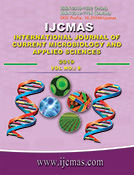


 National Academy of Agricultural Sciences (NAAS)
National Academy of Agricultural Sciences (NAAS)

|
PRINT ISSN : 2319-7692
Online ISSN : 2319-7706 Issues : 12 per year Publisher : Excellent Publishers Email : editorijcmas@gmail.com / submit@ijcmas.com Editor-in-chief: Dr.M.Prakash Index Copernicus ICV 2018: 95.39 NAAS RATING 2020: 5.38 |
Extended spectrum β-lactamase (ESBL) producing Enterobacteriaceae has tremendously increased worldwide and it is one of the most common causes of morbidity and mortality associated with hospital-acquired infections. This could be attributed to association of multi drug resistance in ESBL producing isolates. Therefore, in the present study, an attempt was made to know the rate of ESBL producing Enterobacteriaceae and to know their antibiogram at Dr. B.R. Ambedkar Medical College. Bangalore. All the patients with signs and symptoms suggestive of abscess, wound infection, otitis media were included in the study. Pus samples from these patients were processed with standard microbiological procedures and the isolates were screened for ESBL production by Double disk synergy method. Out of 100 isolates, 19 isolates were ESBL producers. The most common ESBL producers were E. coli followed by Klebsiella, Citrobacter and Enterobacter. Majority of ESBL producers showed resistance to Ampicillin, Amoxyclav, cotrimoxazole and Amikacin. The production of ESBLs by clinically important isolates is emerging as a wide spread problem in our set up. Hence, routine detection, appropriate infection control measures are needed to stem the spread of this emerging form of resistance.
 |
 |
 |
 |
 |